LEARNING OBJECTIVES
- Understand the difference between regular verbs and irregular verbs and use both versions correctly.
- Use verb tenses accurately and completely.
- Match infinitives and participles to verb tenses.
What if all coffee makers worked the same way, all vehicles had the exact same dashboard setup, and all verbs followed the exact same format? Life would simply be easier all the way around! But we live in a world of variety, and just as you take the needed steps to become familiar with the coffee maker and car you own, you should also take the effort to become familiar with the language you speak. This section presents an overview of common issues that impede the proper use of English verbs. To understand the possible problems, study the following chart that shows the five main forms of verbs. Notice that for verbs other than be, the present tense for all but third-person singular pronouns is the base verb (third-person singular uses the base verb + –s). The present participle is usually a form of “to be” + the base word + –ing, and the past tense and past participle follow irregular patterns.
|
Base |
Present Tense (+ –s for Third-Person Singular) |
Past Tense |
Past Participle (Preceded by Form of “to Have”) |
Present Participle (Preceded by Form of “to Be”) |
|
run |
run |
ran |
run |
running |
|
smile |
smile |
smiled |
smiled |
smiling |
|
sing |
sing |
sang |
sung |
singing |
|
beat |
beat |
beat |
beaten |
beating |
|
see |
see |
saw |
seen |
seeing |
Using Irregular Verbs Correctly
Some verbs are harder to put in a box. This video from Khan Academy gives an intro to irregular verbs.
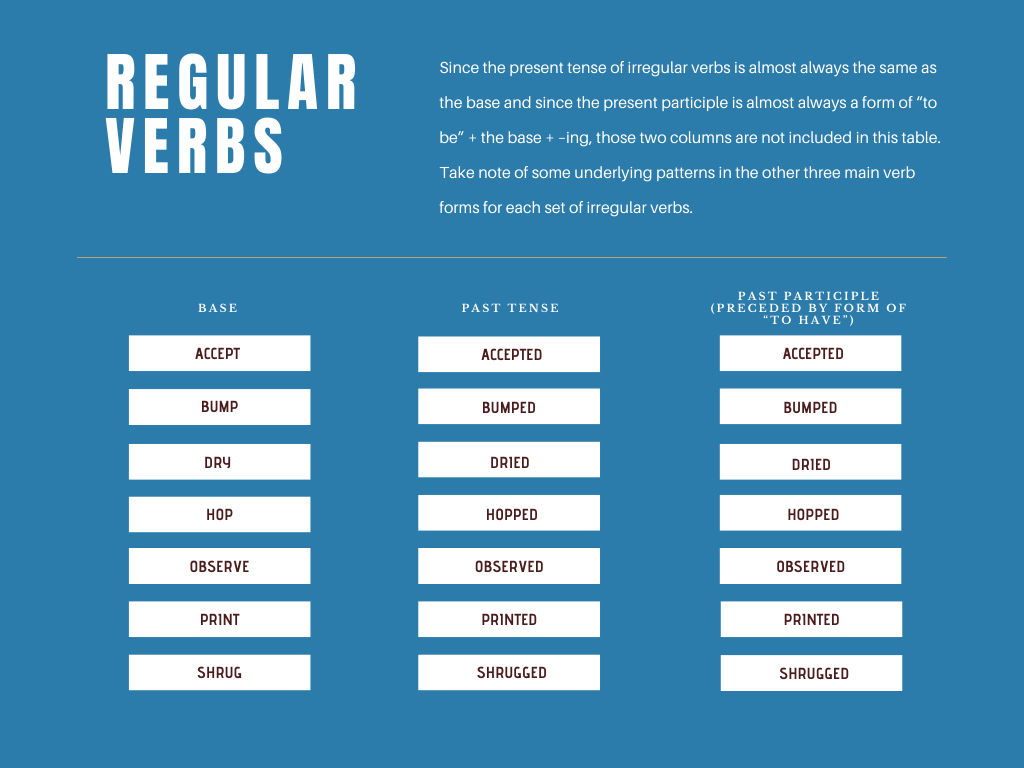
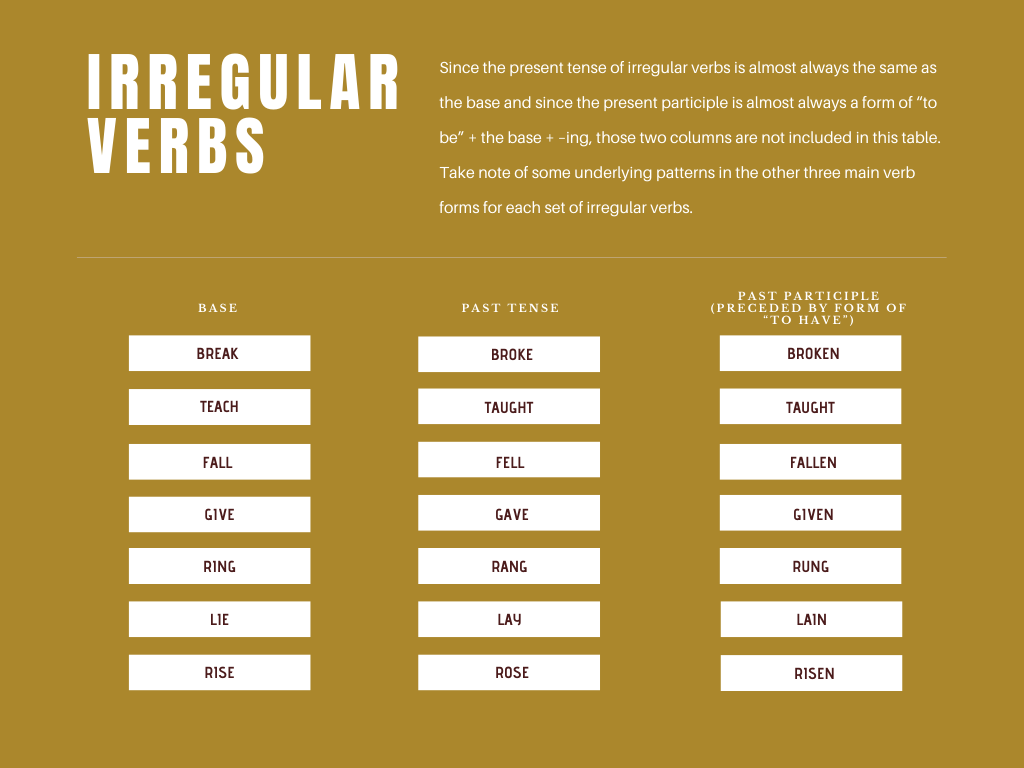
Handling Specific Problematic Verbs
Some verbs are especially problematic either because their meanings are confused or because some of their forms sound alike. Handle these verbs by knowing which ones give you trouble and then focusing on the conjugation of those specific verbs. Some of these most commonly troublesome verbs are in the following table. You need to know two key verb types to read this table: transitive (when an object receives the action of the verb; in other words, something is done to something) and intransitive (a verb that does not act on an object). Click on the individual tables for a closer look.
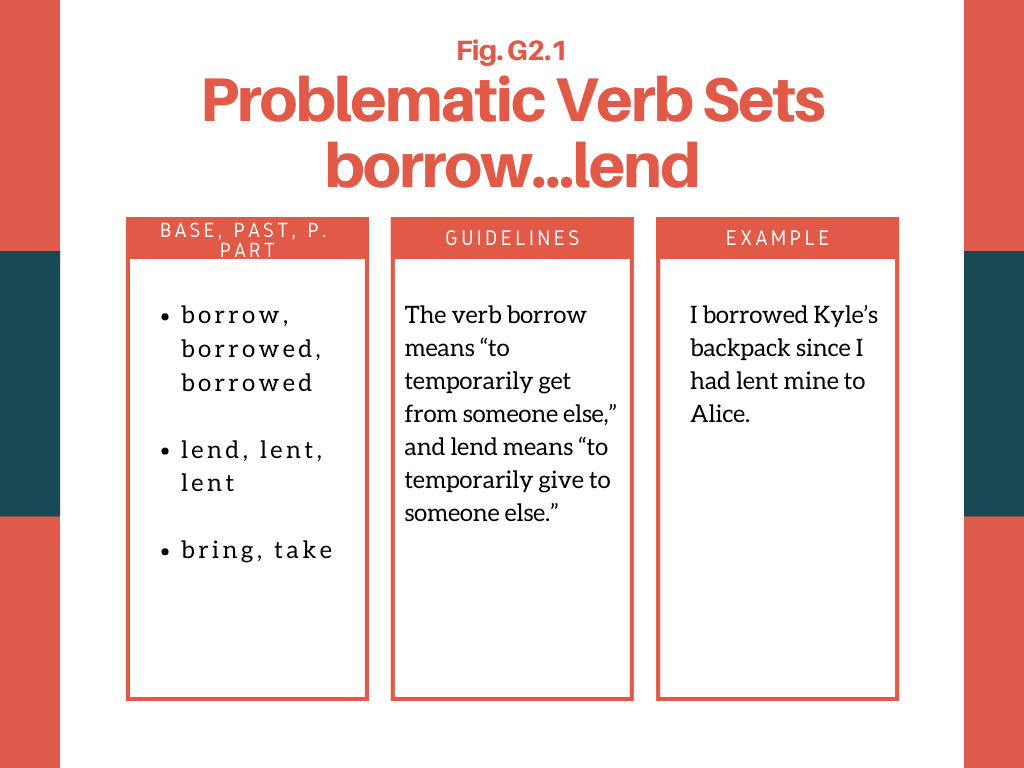
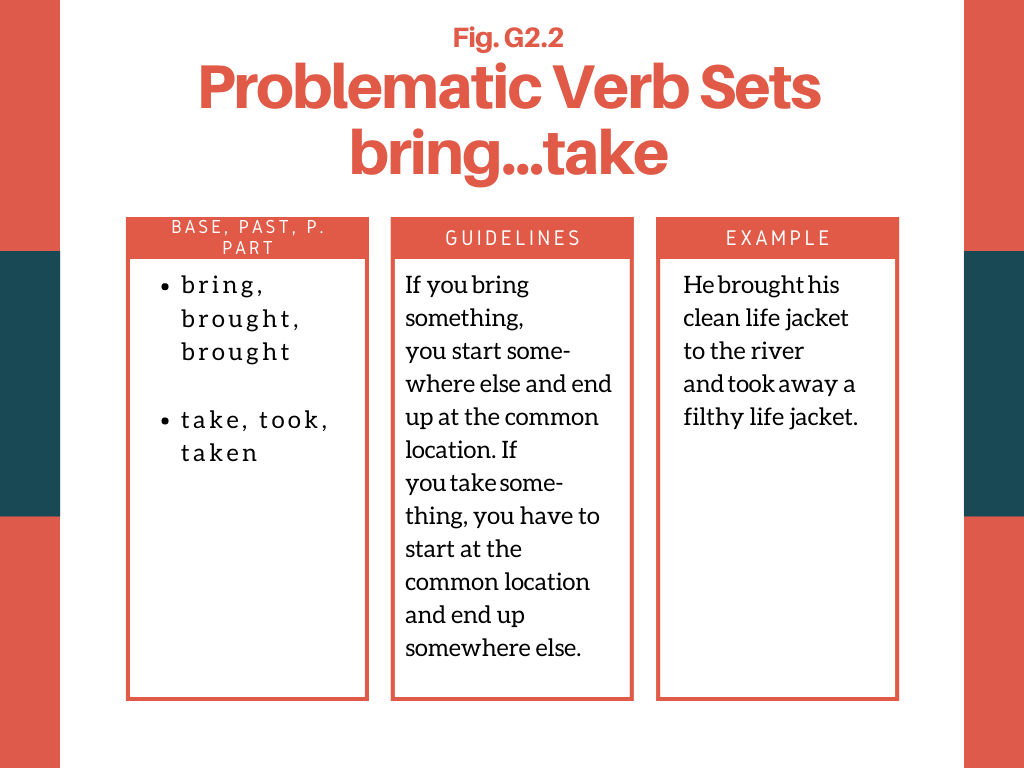
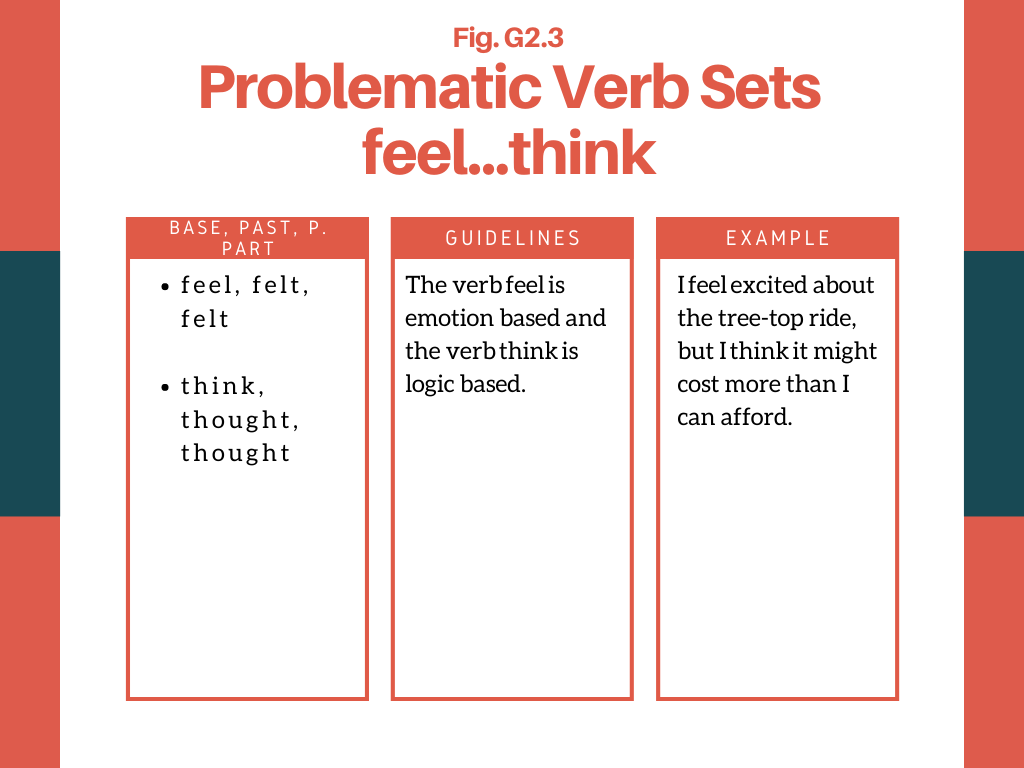
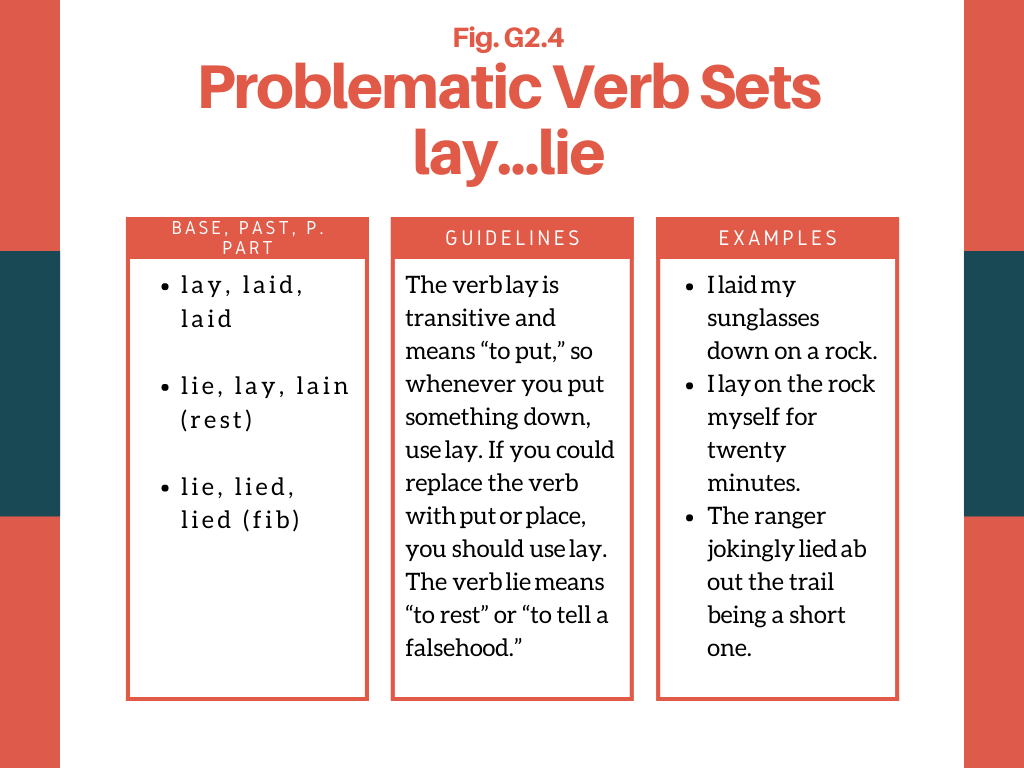
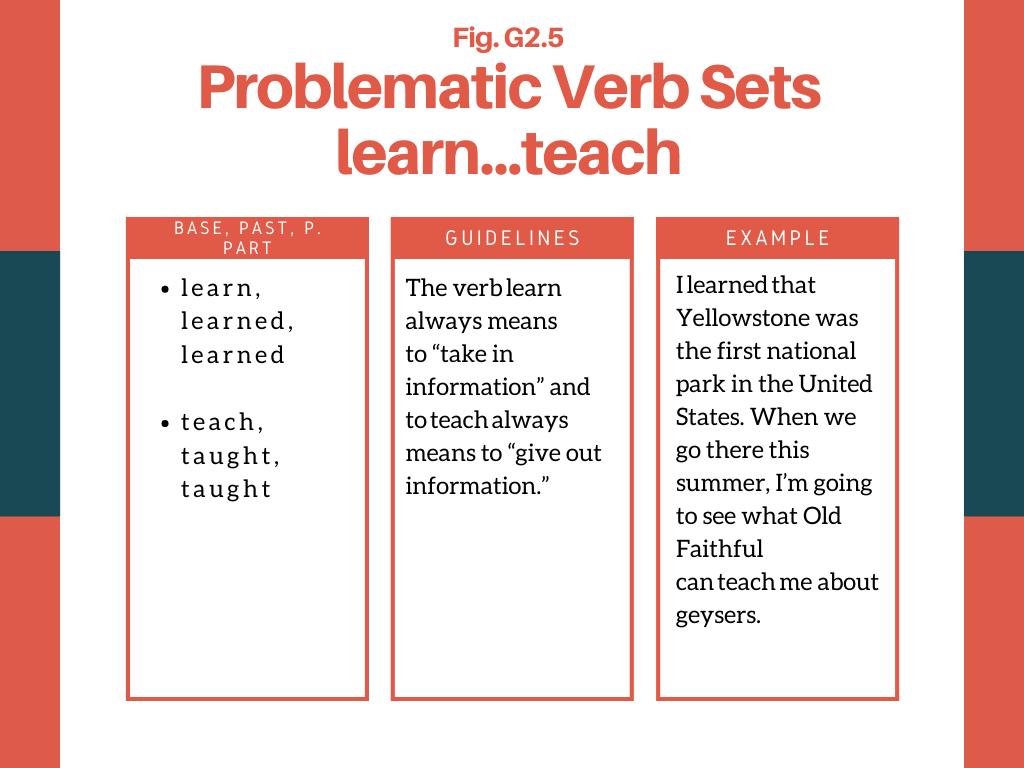

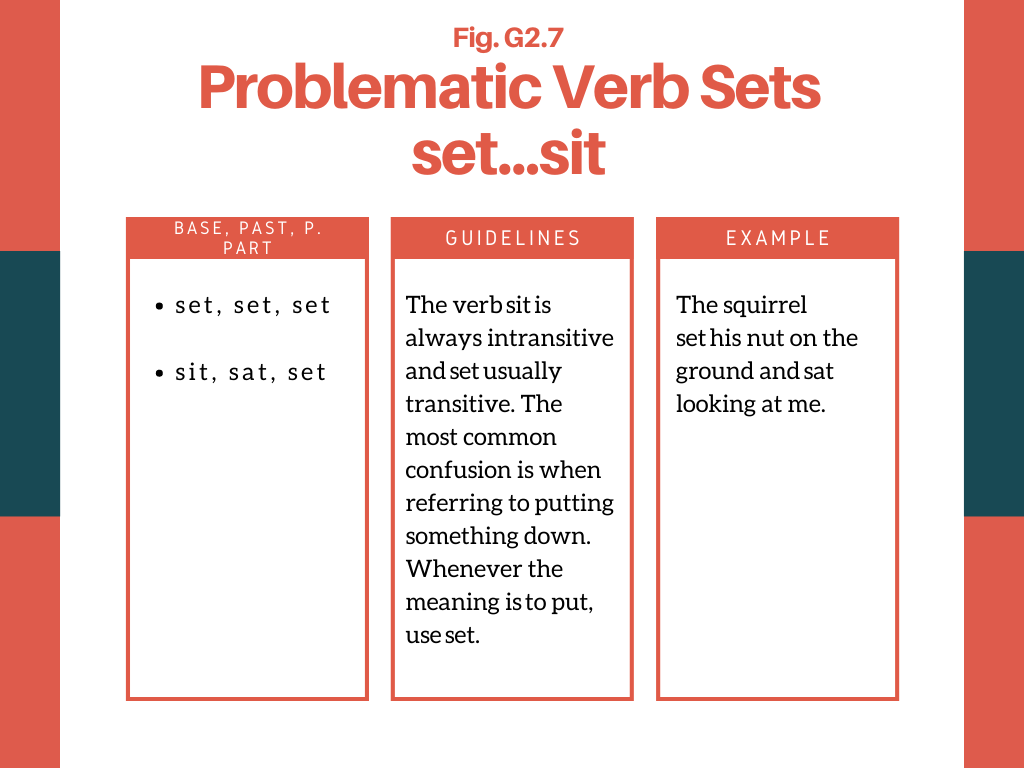
Adding -s and -es for the Third Person
Many verbs require the addition of –s or –es when used in the third-person singular present tense. Although these verbs are slightly different from the present tense form of the verb, they are not considered a separate verb form.
Example
Present tense verb: walk
Present tense verb used in first person: I walk for hours looking at the trees and plants.
Present tense verb used in second person: You walk too quickly for me.
Present tense verb used in third person: He walks around as if he knows where he’s going.
Using Verb Tenses Accurately and Completely
Verb tenses allow you to attach timing to sentences you write and vocalize. To make your meaning clear, you need to choose the correct tense for the timing and you need to be sure to include all the needed words for that tense.
|
Verb Tenses |
Timing of Action |
Additional Words and Endings Needed to Complete Verb |
Examples |
|
Simple present |
Taking place right now |
None |
I hike. |
|
You hike. |
|||
|
She hikes. |
|||
|
Simple past |
Started and finished in the past |
Add –ed to verb. |
I hiked. |
|
You hiked. |
|||
|
She hiked. |
|||
|
Simple future |
Will take place after now |
Add will or shall to the present-tense verb |
I will hike. |
|
You will hike. |
|||
|
She will hike. |
|||
|
Present progressive |
Taking place right now and will continue to take place |
Add am, is, or are to the verb + –ing |
I am hiking |
|
You are hiking. |
|||
|
He is hiking. |
|||
|
Past progressive |
Took place in the past at the same time that another action took place |
Add was or were to the verb + –ing |
I was hiking. |
|
You were hiking. |
|||
|
He was hiking. |
|||
|
Future progressive |
Will take place in the future and will continue on indefinitely |
Add will be or shall be to the verb + –ing |
I will be hiking. |
|
You will be hiking. |
|||
|
He will be hiking. |
|||
|
Present perfect |
Happened at an indefinite time in the past or started in the past and continues now |
Add has or have to the past participle of the verb (usually-ed) |
I have hiked this trail before. (in the past) |
|
I have hiked this trail since I was five years old. (in the past and continues) |
|||
|
Past perfect |
Took place before some other past action |
Add had to the past participle of the verb (usually –ed) |
By the time I saw Jenny, I had hiked past the food station. |
|
Future perfect |
Will take place some time in the future before some other action |
Add will have to the past participle of the verb (usually-ed) |
I will have hiked for two hours before you even wake up. |
|
Present perfect progressive |
Began in the past, continues now, and might continue into the future |
Add has or have been to the verb +ing |
I have been hiking for a while. |
|
Past perfect progressive |
Took place on an ongoing basis in the past and was completed before another past action |
Add had been to the verb + –ing |
You had been walking for an hour when you saw the swans. |
|
Future perfect progressive |
Takes place in the future on an ongoing basis |
Add will have been to the verb + –ing |
They will have been hiking once a week by then. |
Matching Infinitives and Participles to Verb Tenses
Verbals are words formed from verbs that function as other parts of speech. One type of verbals, gerunds (laughing, eating), always function as nouns (e.g., “Laughing is good for you”). Present, past, and present perfect participles are verbals that function as adjectives (e.g., “The sound of laughing children always cheered him up,” “The sight of the broken tricycle left in the rain made him gloomy”). Infinitives (to laugh, to have eaten) are another main type of verbals that function as nouns, adjectives, or adverbs. When using any of these verbals, make sure you match the tense of the verb in the sentence.
Infinitives
When the action of the infinitive takes place after or at the same time as the action of the main verb, use the present tense:
- We plan to camp in the National Redwood Forest this week.
When the action of the infinitive takes place before the action of the main verb, present the infinitive in perfect tense:
- We planned to have been camping in the National Redwood Forest last week.
Participle Phrases
Participle phrases can begin with the present participle, past participle, or present perfect participle.
The present participle is the correct choice when the action of the participle is happening at the same time as the action of the main verb:
- Resulting in large openings called goosepen scars, fire ravages redwood trees without killing them.
When the action of the participle takes place before the action of the main verb, you can use either a past participle or a present perfect participle:
- Scarred by a fire years ago, the large redwood tree still stands tall and awesome. (past participle in participle phrase)
- Having posed for several pictures inside the redwood trunk, we climbed out and previewed the shots.
Adapted from “Grammar” in Writer’s Handbook, 2012, used according to Creative Commons CC BY-NC-SA 3.0